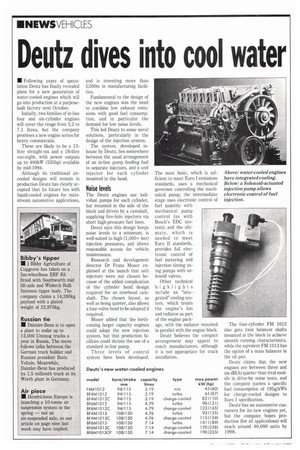Deutz dives into cool water
Page 10

If you've noticed an error in this article please click here to report it so we can fix it.
• Following years of speculation Deutz has finally revealed plans for a new generation of water-cooled engines which will go into production at a purposebuilt factory next October.
Initially, two families of in-line four and six-cylinder engines will cover the range from 3.2 to 7.1 litres, but the company promises a new engine series for heavy commercials.
These are likely to be a 12litre straight-six and a 16-litre vee-eight, with power outputs up to 400kW (535hp) available by mid-1994.
Although its traditional aircooled designs will remain in production Deutz has clearly accepted that its future lies with liquid-cooled engines for mainstream automotive applications, and is investing more than 200m in manufacturing facilities.
Fundamental to the design of the new engines was the need to combine low exhaust emissions with good fuel consumption, and in particular the demand for low noise levels.
This led Deutz to some novel solutions, particularly in the design of the injection system.
The system, developed inhouse by Deutz, lies somewhere between the usual arrangement of an in-line pump feeding fuel to separate injectors, and a unit injector for each cylinder mounted in the head.
Noise levels
The Deutz engines use individual pumps for each cylinder, but mounted in the side of the block and driven by a camshaft, supplying five-hole injectors via short high-pressure fuel lines.
Deutz says this design keeps noise levels to a minimum, is well-suited to high (1,000+ bar) injection pressures, and allows reasonable access for vehicle maintenance.
Research and development director Dr Franz Moser explained at the launch that unit injectors were not chosen because of the added complication of the cylinder head design required for an overhead camshaft. The chosen layout, as well as being quieter, also allows a four-valve head to be adopted if required.
Moser added that the forthcoming larger capacity engines could adopt the new injection system, but that production facilities could dictate the use of a standard in-line pump.
Three levels of control system have been developed. The most basic, which is sufficient to meet Euro I emissions standards, uses a mechanical governor controlling the mechanical pump; the intermediate stage uses electronic control of fuel quantity with mechanical pump control (as with Bosch's EDC system); and the ultimate, which is needed to meet Euro II standards, provides full electronic control of fuel metering and injection timing using pumps with solenoid valves.
Other technical highlights include an 'Integrated" cooling system, which treats the engine's fan and radiator as part of the engine package, with the radiator mounted in parallel with the engine block.
Deutz believes the compact arrangement may appeal to coach manufacturers, although it is not appropriate for truck installation. The four-cylinder FM 1012 also gets twin balancer shafts mounted in the block to achieve smooth running characteristics, while the eqivalent FM 1013 has the option of a mass balancer in the oil pan.
Deutz claims that the new engines are between three and six dB(A) quieter than rival models in drive-by noise tests, and the company quotes a specific fuel consumption of 195g/kWh for charge-cooled designs to Euro I specification.
Deutz has no automotive customers for its new engines yet, but the company hopes production (for all applications) will reach around 80,000 units by 1998.


























































































